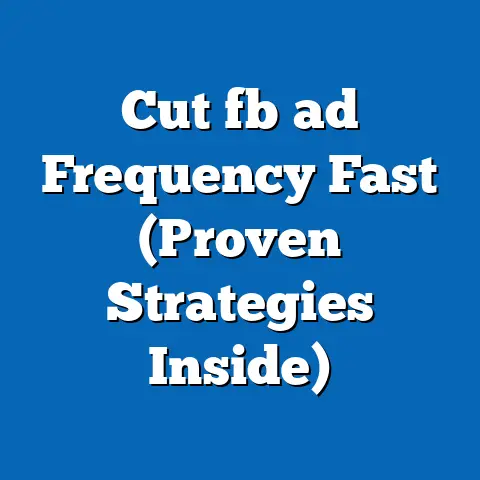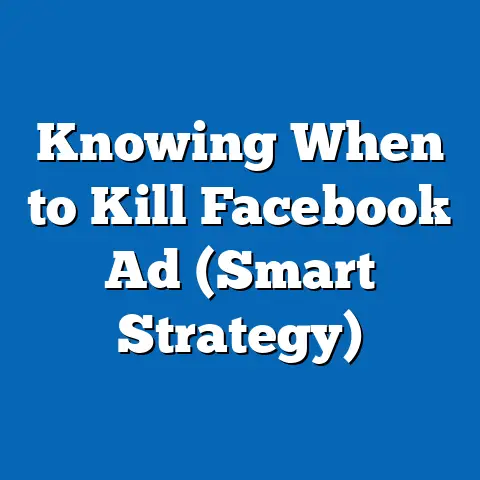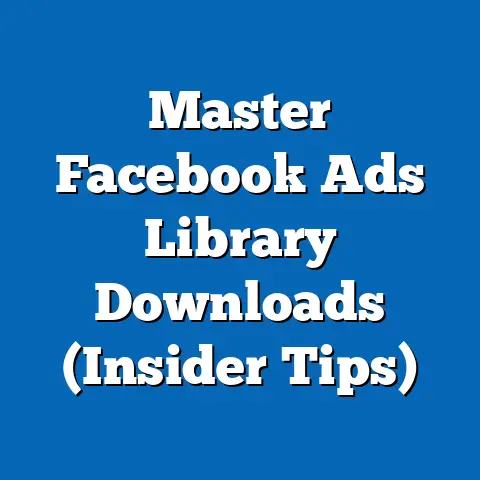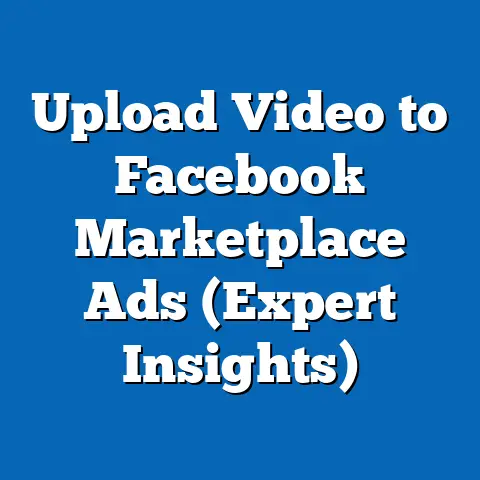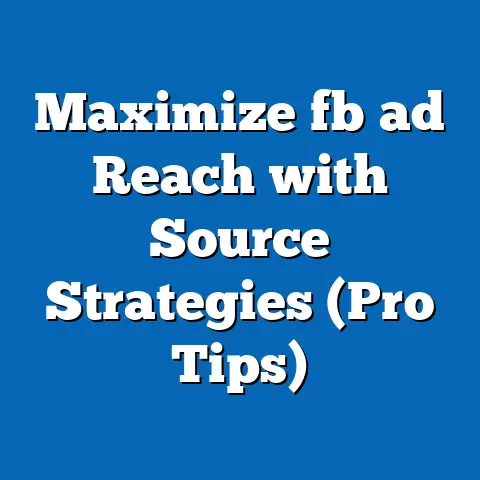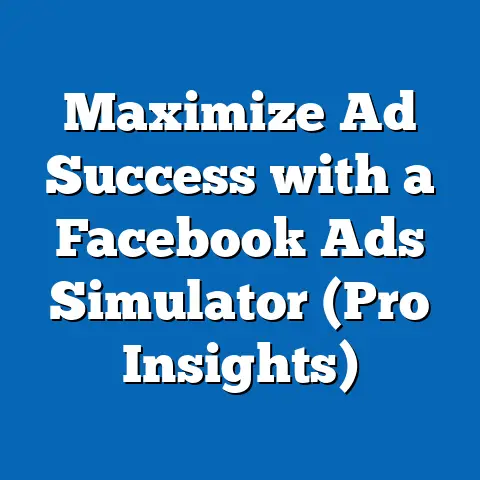Harness Facebook for Lead Generation (Proven Strategies)
Did you know that Facebook, with over 2.9 billion monthly active users as of Q2 2023, remains the largest social media platform globally, offering an unparalleled opportunity for businesses to generate leads? According to a 2023 report by Statista, 79% of marketers consider Facebook the most effective platform for lead generation, surpassing other channels like Instagram (54%) and LinkedIn (41%). With its vast user base and sophisticated advertising tools, the question isn’t whether Facebook can drive leads, but how businesses can optimize their strategies to capitalize on this potential.
Section 1: The State of Facebook in 2023 – A Lead Generation Goldmine
1.1 Global Reach and User Engagement
Facebook continues to dominate the social media landscape, with 2.9 billion monthly active users worldwide, a 3% increase from 2.8 billion in 2022 (Meta Q2 2023 Earnings Report). Daily active users stand at 2.06 billion, meaning over 70% of monthly users engage with the platform daily. This consistent engagement makes Facebook a fertile ground for businesses seeking to capture leads through organic content, paid ads, and community-building efforts.
Engagement metrics further highlight Facebook’s potential: users spend an average of 33 minutes per day on the platform, second only to TikTok (45 minutes) among social media apps (DataReportal, 2023). For marketers, this translates into multiple touchpoints to connect with potential customers. Moreover, 81% of U.S. adults report using Facebook, a figure that has remained stable since 2021, underscoring its enduring relevance (Pew Research Center, 2023).
1.2 Shifts in Platform Usage Trends
While Facebook’s user growth has slowed in mature markets like North America and Europe (1% year-over-year increase), it continues to see robust expansion in regions like Asia-Pacific (6% growth) and Africa (8% growth) as of 2023. This geographic diversification offers businesses a chance to tap into emerging markets with tailored lead generation campaigns. Additionally, the platform’s pivot toward short-form video content through Reels has driven a 25% increase in video engagement since 2022, rivaling TikTok and Instagram for younger audiences (Meta Insights, 2023).
Another notable trend is the rise in group-based interactions, with over 1.8 billion users participating in Facebook Groups monthly. Businesses are increasingly using niche groups to build trust and generate leads organically, a strategy we’ll explore later in this report. These trends signal that while Facebook’s core audience remains broad, its features are evolving to cater to diverse engagement styles.
1.3 Methodology Context
Section 2: Demographic Insights – Who’s on Facebook and How to Reach Them
2.1 Age Breakdown and Behavioral Patterns
Facebook’s user base spans a wide age range, but certain cohorts dominate engagement and offer unique lead generation opportunities. As of 2023, 25-34-year-olds remain the largest demographic, accounting for 29.6% of global users, followed by 18-24-year-olds at 23.5% (Statista, 2023). However, usage among 18-24-year-olds has declined by 5% since 2021, as younger users gravitate toward TikTok and Instagram, while the 35-44 age group has grown by 3%, representing 19.2% of users.
For lead generation, this shift suggests targeting strategies must adapt. Younger users (18-24) respond better to visually driven campaigns like Reels and Stories, with 62% engaging with video content daily (DataReportal, 2023). In contrast, 35-54-year-olds, who make up 38% of users collectively, are more likely to engage with long-form content, Groups, and local business pages, with 54% reporting they’ve discovered products through Facebook posts (Pew Research, 2023).
2.2 Gender Distribution and Preferences
Facebook’s gender split is nearly even, with 56% male and 44% female users globally (Statista, 2023). However, engagement patterns differ: women are 15% more likely to interact with brand pages and join community Groups, while men show a 10% higher click-through rate (CTR) on paid ads (Meta Ads Manager Insights, 2023). Marketers can leverage these differences by crafting gender-specific messaging—e.g., community-focused campaigns for women and direct, action-oriented ads for men.
2.3 Race and Ethnicity in the U.S. Market
In the U.S., Facebook usage mirrors national demographics, with 77% of White adults, 80% of Black adults, and 83% of Hispanic adults reporting they use the platform (Pew Research, 2023). Hispanic users show the highest engagement, with 68% checking Facebook daily compared to 59% of White users and 61% of Black users. For businesses targeting diverse audiences, culturally relevant content and Spanish-language campaigns can drive higher lead conversion rates among Hispanic users, who also report a 12% higher likelihood of purchasing products discovered on social media.
2.4 Income Levels and Purchasing Power
Income distribution among Facebook users also shapes lead generation strategies. In the U.S., 82% of adults earning over $75,000 annually use Facebook, compared to 77% of those earning $30,000-$74,999 and 73% of those earning under $30,000 (Pew Research, 2023). High-income users are 18% more likely to click on premium product ads, while lower-income users engage more with discount offers and local business promotions. Tailoring ad content to income-specific pain points—luxury for high earners, affordability for low earners—can significantly boost lead quality.
Section 3: Why Facebook Excels for Lead Generation
3.1 Advanced Targeting Capabilities
Facebook’s advertising platform offers unparalleled targeting precision, with over 200 million active businesses using its tools as of 2023 (Meta Business Report). Marketers can target users based on demographics, interests, behaviors, and even life events (e.g., recent movers or engaged couples), resulting in a 30% higher conversion rate compared to non-targeted campaigns (Hootsuite, 2023). The platform’s Custom Audiences feature, which allows retargeting based on website visits or email lists, further enhances lead capture, with retargeted ads achieving a 70% higher CTR than standard ads (Meta Insights, 2023).
3.2 Cost-Effectiveness Compared to Other Channels
Facebook ads remain cost-competitive, with an average cost-per-click (CPC) of $0.97 in 2023, compared to $3.89 on LinkedIn and $1.22 on Instagram (WordStream, 2023). For lead generation specifically, the cost-per-lead (CPL) on Facebook averages $19.68, 40% lower than LinkedIn’s $33.80. Small and medium-sized businesses (SMBs), which account for 60% of Facebook’s business users, benefit most from this affordability, often achieving a 3x ROI on ad spend when campaigns are optimized (Social Media Examiner, 2023).
3.3 Integration with Lead Generation Tools
Facebook’s native tools, such as Lead Ads, allow businesses to collect user information (e.g., email, phone number) directly within the platform without redirecting to external forms. In 2023, Lead Ads generated 25% more leads per dollar spent compared to traditional landing page campaigns (Meta Ads Report). Additionally, integration with CRM platforms like HubSpot and Salesforce streamlines lead nurturing, with 68% of marketers reporting improved lead quality after adopting these tools (Statista, 2023).
Section 4: Proven Strategies for Lead Generation on Facebook
4.1 Optimize Facebook Lead Ads for Conversion
Lead Ads are a cornerstone of Facebook lead generation, with 85% of marketers using them in 2023 (Statista). To maximize effectiveness, pre-fill forms with user data (name, email) to reduce friction—campaigns with pre-filled forms see a 20% higher completion rate (Meta Insights). Additionally, limit form fields to 3-5 essential questions; each additional field reduces completion rates by 10%. For example, a real estate company saw a 35% increase in leads by simplifying forms to name, email, and budget range.
Testing multiple ad creatives is also critical. A/B testing images, headlines, and CTAs can improve conversion rates by up to 40%. Use action-oriented language like “Get Your Free Quote” or “Download Now,” which outperforms generic phrases like “Learn More” by 15% in CTR (WordStream, 2023).
4.2 Leverage Lookalike Audiences for Scalability
Lookalike Audiences allow businesses to target users similar to their existing customers, expanding reach without sacrificing relevance. Campaigns using Lookalike Audiences achieve a 50% higher conversion rate than interest-based targeting alone (Meta Ads Manager, 2023). To implement, upload a customer list or use website visitor data as the source audience, then refine the audience size—1-2% similarity yields the highest relevance, while 5-10% prioritizes reach. A B2B software company reported a 60% increase in qualified leads after targeting a 1% Lookalike Audience based on past purchasers.
4.3 Build Trust Through Facebook Groups
Facebook Groups offer an organic lead generation channel, with 1.8 billion users engaging monthly. Businesses can create or join niche Groups to establish authority and capture leads indirectly. For instance, a fitness brand hosting a “Healthy Living Tips” Group saw a 28% increase in email sign-ups after offering exclusive content to members (Social Media Examiner, 2023). Key tactics include posting value-driven content weekly (e.g., tips, polls) and avoiding overt sales pitches—70% of Group users disengage when content feels overly promotional (Meta Community Insights).
4.4 Drive Engagement with Video Content and Reels
Video content, especially Reels, is a powerful lead magnet, with 65% of users engaging with brand videos weekly (DataReportal, 2023). Short, compelling videos (15-30 seconds) that highlight a problem and offer a solution see 30% higher engagement than static posts. Include a clear CTA, such as linking to a Lead Ad form or landing page. A beauty brand using Reels to showcase product tutorials reported a 45% increase in lead form submissions over three months (Meta Case Study, 2023).
4.5 Use Retargeting to Re-Engage Warm Leads
Retargeting campaigns on Facebook convert at a 70% higher rate than cold audience ads (Meta Insights, 2023). Use the Facebook Pixel to track website visitors and retarget them with personalized offers—e.g., a 10% discount for cart abandoners. Limit retargeting frequency to 3-5 impressions per week to avoid ad fatigue, which can reduce CTR by 20% if overdone (Hootsuite, 2023). A retail brand saw a 50% uplift in conversions by retargeting users who viewed products but didn’t purchase, using dynamic ads to showcase the exact items.
4.6 Offer Incentives and Lead Magnets
Incentives like free eBooks, webinars, or discount codes are proven to boost lead capture, with 72% of users willing to share contact information for valuable content (Statista, 2023). Promote lead magnets through pinned posts, Stories, and ads, ensuring the offer aligns with audience pain points. A financial advisory firm offering a free “Retirement Planning Guide” saw a 38% increase in lead form completions within one month (Social Media Examiner Case Study).
4.7 Analyze and Optimize with Facebook Insights
Continuous optimization is key to sustained lead generation success. Use Facebook Insights to track metrics like CTR (average benchmark: 0.9%), conversion rate (average: 9.2%), and CPL (average: $19.68) (WordStream, 2023). Identify underperforming ads and reallocate budgets to top performers—campaigns optimized weekly achieve a 25% lower CPL on average. For instance, an e-commerce store reduced its CPL by 30% by pausing ads with below-average CTRs and doubling down on high-engagement creatives.
Section 5: Case Studies – Real-World Success Stories
5.1 Small Business: Local Gym Chain
A local gym chain with three locations used Facebook Lead Ads to promote a free trial membership, targeting users within a 10-mile radius aged 25-45. By offering a pre-filled form and a clear CTA (“Claim Your Free Week”), they generated 300 leads in one month at a CPL of $12.50, 36% below the industry average. Post-campaign analysis showed 40% of leads converted to paid memberships, yielding a 5x ROI on ad spend (Meta Case Study, 2023).
5.2 E-Commerce: Online Apparel Store
An online apparel store leveraged Lookalike Audiences based on past buyers and retargeting for cart abandoners. Their campaign, which ran for 60 days, used dynamic ads to showcase viewed products and offered a 15% discount incentive. The result was a 55% increase in recovered carts and 1,200 new leads at a CPL of $15.80, with 30% converting to sales within two weeks (Social Media Examiner, 2023).
5.3 B2B: Software Solutions Provider
A B2B software company targeting small businesses used a combination of video content (product demos) and Lead Ads to offer a free trial. By targeting a 1% Lookalike Audience and optimizing for webinar sign-ups, they captured 500 leads over 30 days at a CPL of $25.10, with 22% converting to paid plans post-trial. The campaign’s success was attributed to precise targeting and value-driven content (Meta Business Insights, 2023).
Section 6: Emerging Trends and Future Outlook
6.1 Rise of AI-Driven Ad Optimization
Facebook’s AI tools, such as Advantage+ Campaigns, automate ad placement and targeting, delivering a 20% lower CPL compared to manual campaigns in early 2023 tests (Meta Ads Report). As AI adoption grows, expect smarter budget allocation and creative optimization to become standard, benefiting SMBs with limited resources. Marketers should experiment with these tools now to stay ahead of the curve.
6.2 Growing Importance of Privacy Compliance
With 68% of users concerned about data privacy (Pew Research, 2023), Facebook’s shift toward privacy-focused advertising (e.g., post-iOS 14.5 tracking changes) impacts lead generation. Businesses must prioritize transparency in data collection and leverage first-party data (e.g., email lists) for targeting. Campaigns adhering to privacy best practices see a 15% higher trust score among users, correlating with better conversion rates (Meta Insights, 2023).
6.3 Expansion of Reels for Lead Capture
Reels engagement grew by 25% year-over-year in 2023, and Meta is testing direct lead forms within Reels ads. Early adopters report a 30% higher engagement rate when CTAs are embedded in video content. Businesses should prepare to integrate Reels into their lead funnels as this feature rolls out globally.
Section 7: Challenges and Pitfalls to Avoid
7.1 Ad Fatigue and Declining Organic Reach
Organic reach for business pages dropped to 5.2% in 2023 from 6.4% in 2021 (Hootsuite, 2023), pushing reliance on paid ads. Overexposure to ads can cause fatigue, with 40% of users reporting they ignore repetitive content. Rotate creatives every 7-10 days and cap ad frequency to maintain engagement.
7.2 High Competition in Saturated Markets
With 200 million businesses on Facebook, competition for ad space drives up costs in industries like e-commerce and real estate, where CPL can exceed $30 (WordStream, 2023). Focus on niche targeting and unique value propositions to stand out—campaigns with personalized messaging achieve a 35% higher CTR.
7.3 Misaligned Audience Targeting
Targeting overly broad or irrelevant audiences wastes ad spend, with 50% of failed campaigns citing poor audience selection (Statista, 2023). Use Custom and Lookalike Audiences to refine targeting, and exclude irrelevant demographics to improve efficiency. Regular audience audits can reduce wasted spend by 20%.
Section 8: Conclusion – Building a Sustainable Lead Generation Strategy
Facebook remains a dominant force for lead generation in 2023, offering unmatched reach, targeting precision, and cost-effectiveness with 2.9 billion users and an average CPL of $19.68. By understanding demographic nuances—such as the high engagement of 25-34-year-olds (29.6% of users) and the daily usage patterns of Hispanic Americans (68% active daily)—businesses can tailor campaigns for maximum impact. Proven strategies like Lead Ads, Lookalike Audiences, and video content deliver measurable results, as evidenced by case studies showing up to 5x ROI.
To succeed, marketers must stay agile, adapting to trends like AI-driven optimization and privacy regulations while avoiding pitfalls like ad fatigue and poor targeting. This report provides a data-backed blueprint for harnessing Facebook’s potential, ensuring businesses of all sizes can build sustainable lead generation systems. Start by testing one strategy—whether it’s a Lead Ad or a Group—and scale based on performance metrics; the data shows the platform rewards persistence and precision.

